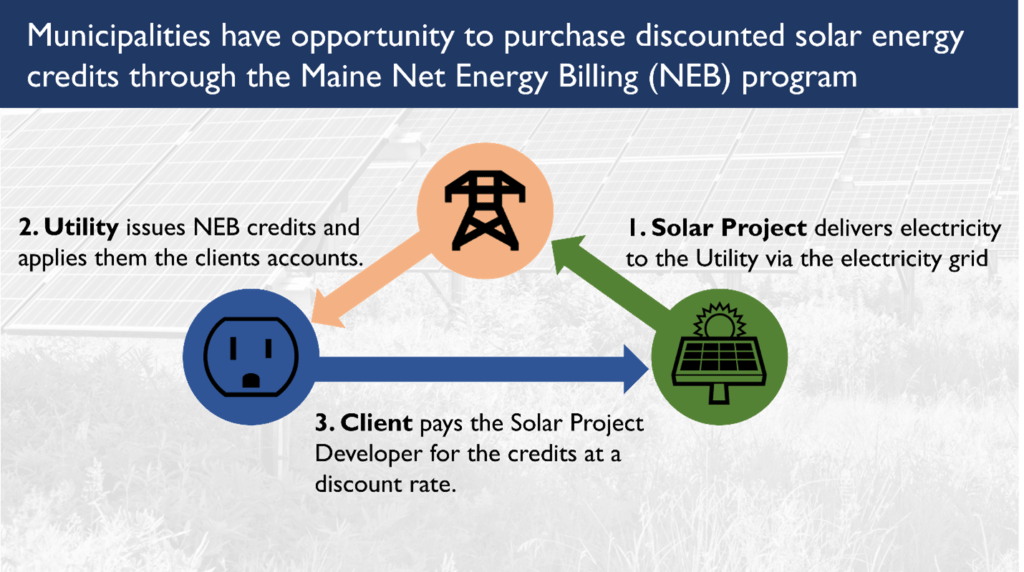Local Government:
Southern Maine Planning & Development Commission, MaineCategory:
Aggregation, Partnerships and CollaborationsProject Purpose
Help five Southern Maine Planning & Development Commission (SMPDC) member towns (Fryeburg, Kennebunkport, Kittery, Ogunquit, and Old Orchard Beach) take advantage of Maine’s new Net Energy Billing program and purchase solar together at a lower cost.

Project Overview
In 2019, the state of Maine passed legislation eliminating “gross metering,” which required solar panel owners to install a second meter to measure excess electricity they produced through their solar project, which was supplied back to the state’s electric grid. Meanwhile, a new Net Energy Billing program was established to allow Maine municipalities to offset their electric bills by using small-scale, renewable electricity generation facilities. See the below graphic for more information on how the Net Energy Billing program works.
The Southern Maine Planning and Development Commission (SMPDC) established the Southern Maine Solar Collaborative (SMSC) to take advantage of this new Net Energy Billing program and help multiple local governments purchase solar together at a lower cost. Through the SMSC, five member towns (Fryeburg, Kennebunkport, Kittery, Ogunquit, and Old Orchard Beach) have implemented a joint procurement process for a single, 20-year master contract. This essentially means that municipalities can get solar energy from farms that are not located within their town or connected to their municipal buildings — often at a discounted price.
Together, the SMSC is purchasing solar credits equivalent to 68% of its aggregated electricity use, worth $823,000 in 2021. Using a joint procurement process, the collaborative secured a discount rate of 27.5% off the credit price. This will save the municipalities approximately $226,000 per year on electricity costs based on 2021 rates — and likely even more given the significant increase in electricity rates in 2022. If electricity prices remain the same, together the towns will save about $4.5 million over the 20-year lifespan of the contracts.
The advantages of the SMSC’s collaborative procurement process include better pricing options for member organizations enabled by larger procurement, reduced municipal staff time, competitive contract terms, and more. According to RMI’s Aggregation Procurement Guide for Local Governments, aggregated deals like this also allow smaller towns that might normally have a difficult time purchasing renewable energy to do so more easily and efficiently. And beyond the financial and climate benefits, the collaborative process aids peer learning. SMSC sustainability staff and land use planners work to educate towns about solar procurement, development review, and other challenges and opportunities related to purchasing renewables.
In addition to reducing municipal electricity costs, the SMSC’s procurement process is a huge step forward in reducing the towns’ climate impacts. As part of their contracts, the towns will receive all of the renewable energy credits (RECs) generated by their solar allocations. These RECs can be used to offset municipal carbon emissions and meet greenhouse gas emissions reduction goals. By keeping and retiring their RECs, the municipalities are directly investing in the local green energy economy.
This model also benefits solar companies, as it features a streamlined process in which companies can see cities’ and towns’ needs all at once, rather than having to individually approach each locale.
In response to the initial request for proposals (RFP), the SMSC received seven proposals from solar developers offering a total of nine bids with varying rate structures. The bid was awarded to Encore Renewable Energy and, in 2021, the program procured 5.3 MW of aggregated net-metering solar credits on behalf of seven different local entities.
“This program aims to help [municipalities] offset their electric bills using the output from small renewable generators, to support renewable energy generation in the state, and reduce greenhouse gas emissions in their town.”
Karina Graeter, Sustainability coordinator of smpdc

How was the deal structured?
The SMSC is structured such that member organizations participate in a shared, voluntary, cooperative initiative to implement a joint procurement process for a master net energy billing contract agreement that may be adopted by all participating members.
What were Fryeburg, Kennebunkport, Kittery, Ogunquit, and Old Orchard Beach’s biggest challenges in setting up this project?
Determining allocations. For the Net Energy Billing Credit agreements, municipalities need to determine the amount of solar they would like allocated by account. Determining the allocation amounts for hundreds of electricity accounts across six different entities was complex and time-consuming.
Waiting for a commercial operation date. For all solar projects, there is a long wait between when the contracts are signed and when the solar farms actually begin to produce electricity. There have been a number of factors that have made this wait particularly drawn out, confusing, and frustrating for SMSC members. Challenges such as interconnection cluster studies, revisions to Maine’s Net Energy Billing law, pandemic-induced labor and supply chain delays, and the US Commerce Department’s solar tariff investigation on panels imported from Southeast Asia have all caused delays in the projects’ timeline.
What advice would Fryeburg, Kennebunkport, Kittery, Ogunquit, and Old Orchard Beach give other local governments as they pursue climate action projects?
Work together. Many of your municipality’s climate priorities are likely similar to those of your neighboring municipalities. Collaborate to tackle challenging projects; doing so can decrease costs, increase efficiencies, and provide valuable perspectives to your climate action projects.
Lead by example in your community. Municipalities can demonstrate the benefits of different climate actions to their community members. Make sure to engage your community about why you are participating in climate action projects and programs. It’s a perfect opportunity to educate and inspire others to take action as well.
“Kittery is excited to be a part of this regional effort. The project will allow us to take action on our shared climate goals by shifting our electricity use to renewable energy sources, and combine our buying power to lower electricity costs.”
Kendra Amaral, Kittery Town Manager

How does this project fit into Fryeburg, Kennebunkport, Kittery, Ogunquit, and Old Orchard Beach’s broader climate and community goals?
In 2019, the SMPDC established its Regional Sustainability and Resilience Program, a two-year pilot program that helps each town accomplish its individual coastal resilience and sustainability objectives. The program’s key goals include collaboration, assessment, integration, and action.
The SMSC helps the SMPDC accomplish a critical pillar of its sustainability agenda: renewable energy procurement, policy, and outreach.
The SMSC also helps the state of Maine reach the goals laid out in its four-year climate action plan, particularly “Strategy C: Reduce Carbon Emissions in Maine’s Energy and Industrial Sectors through Clean-Energy Innovation.” Collaborative procurement processes like that of the SMSC will help Maine reach its goal of having 80% of its electricity usage come from renewable generation by 2030.
Additional Information and Resources
- Southern Maine Solar Collaborative website
- Southern Maine Solar Collaborative Memorandum of Understanding (Project MoU)
- SMPDC Sothern Main Solar Collaborative Request for Proposals Q & A Summary (Q&A from RFP process in spring 2021)
- How a joint procurement approach is a win for these Southern Maine towns (New Project Media writeup on SMSC)
- SMPDC Regional Sustainability and Resilience Program (Information about the SMPDC program)
- Southern Maine Municipal Solar Forum (Pre-recorded webinar) (Webinar featuring various solar projects in Maine, including the SMPDC project)
- Southern Maine towns participating in a solar collaborative (News article)
- How a 2019 Maine law spurred $100 million in solar investment (News article)
- Kennebunkport joins solar power collaborative (News article)
- ‘Just plain great’: New energy contract to save Kennebunkport $30K per year (News article)
- Southern Maine towns seek proposals from solar developers to help reduce energy costs (News article)
This project was included on the Renewables Accelerator’s list: 10 of the Most Noteworthy Local Government Renewables Deals of 2021.
